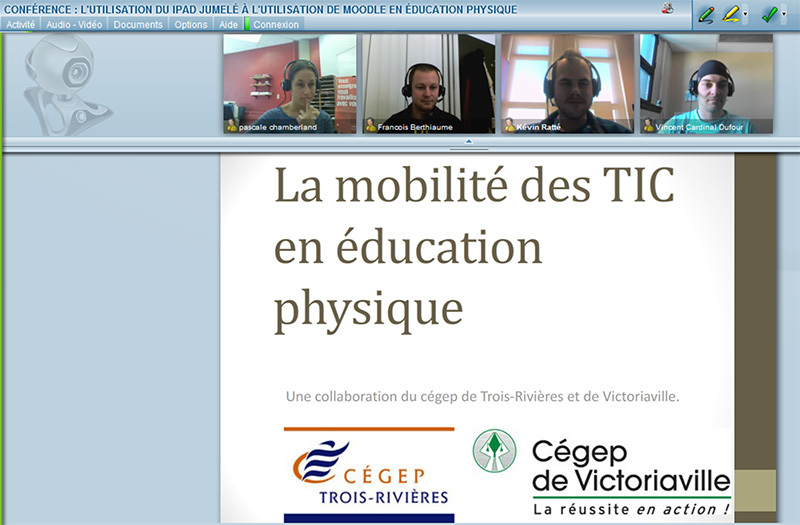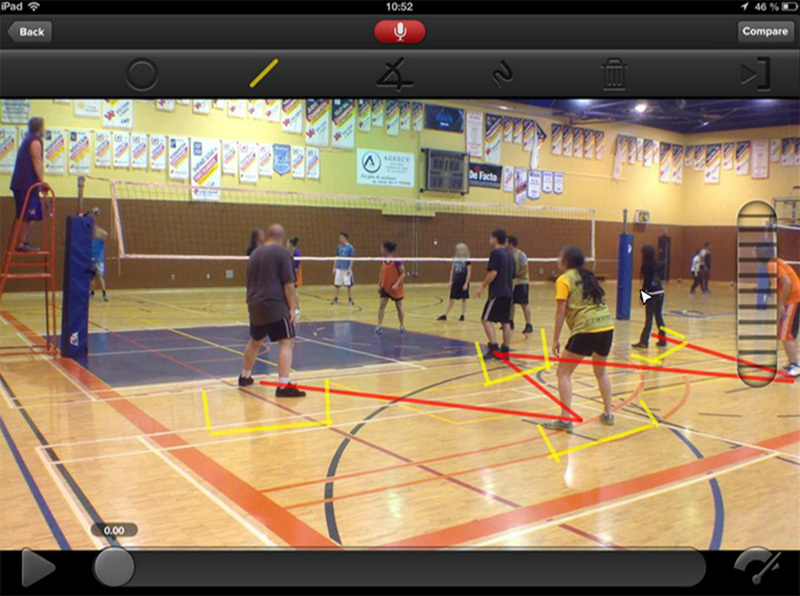We’ve Got Highlights: Tablets and Moodle in Physical Education for Student Performance Enhancement
On Wednesday, March 11th, 2015, close to 30 educators from Quebec, New Brunswick, Ontario and Manitoba attended an online lunch-and-learn presentation entitled The iPad: Fun and Simple Gadget or Relevant Pedagogical Tool in Physical Education? [translation].
Profweb was invited to attend this presentation, which was organized under the auspices of the Réseau des cégeps et des collèges francophones du Canada (RCCFC). This organization has a mandate to promote partnerships and the sharing of expertise between Francophone colleges across the country. They certainly succeeded in organizing an informative and inspiring presentation, which was led by four PhysEd Teachers from two different CEGEPs: Vincent Cardinal Dufour and Kévin Ratté from the Cégep de Victoriaville, and Pascale Chamberland and François Berthiaume, from the Cégep de Trois-Rivières. The two colleges were partners in an RCCFC project to encourage the use of mobile technology in the classroom entitled Échange d’expertise en integration de la pédagogie mobile en enseignement postsecondaire.

The presentation facilitators from Cégep de Trois-Rivières and Cégep de Victoriaville
Technology in Service of Physical Education
The use of Information and Communication Technologies (ICTs) in Physical Education has not always been an easy proposition. Since many physical activities occur outdoors or within a gymnasium where workstations would be an unwelcome obstacle, tablets provide an interesting compromise, as they are wireless and much less cumbersome to carry.
Each of the presenters had anywhere from two to four years of experience teaching Physical Education with iPads. In most cases, the Teachers were using the iPad in the second (of three) PhysEd courses from the General Education component. This course, typically known as Physical Activity and Effectiveness, requires students to choose a sport in which they must try to improve their ability throughout the semester. They analyse their initial level of performance, create objectives for improvement, and then organize a plan to achieve these objectives. Students perform a mid-term evaluation to see whether they are on track (no pun intended), or whether adjustments to their plan and activity are required.
Popular Apps for Physical Education
For the Teachers from Victoriaville, Ubersense has revolutionized their teaching practice. The key function of this app is to be able to review captured video in slow motion so that each student’s movement can be dissected in great detail. It also allows the Teacher to provide immediate visual feedback to the students, and to record audio commentary while the video is being captured.
Slow motion demonstration of a popular Frisbee throwing technique
Teachers can then digitally mark up the video with integrated tools, such as a digital light pen (much like sportscasters use on tv). The app also allows the Teacher to measure angles, which is useful to evaluate the efficiency and effectiveness of the student’s posture, stance and movements. Two videos can be placed side-by-side to compare performance with other students or with videos of professional athletes. One example that was often used to illustrate the utility of the application was filming a smash in badminton. This action happens so quickly that the Teacher used to require students to make multiple attempts in order to properly analyse the technique used and overall performance. The instant nature of filming combined with slow motion replay makes teaching more efficient. The timeliness of the feedback also allows both an individual student and an entire team to quickly adjust their performance based on visual feedback. The tool also has export controls for quick posting to YouTube, social media and popular cloud storage services. Ubersense is available for both Apple’s iOS platform as well as Android.

View of the Ubersense interface with markup tools and controls for playback speed
The presenters also mentioned that some colleagues use the TotalCoaching web platform in their class, which allows students to have a personalized training program, track results, follow a nutritional program and interact with their ‘Trainer’. Other applications for race management, maintaining pace while running, and relaxation apps were also mentioned as potential tools to explore in Physical Education.
Combing Mobile Technology and Moodle in Physical Education
The next part of the presentation was led by the Trifluvienne Teachers from the Cégep de Trois-Rivières. They began with an overview of some of the issues they had encountered over time with their students. Lost paperwork, lack of visual feedback for learners, as well as teacher and student absences can all have a negative impact on the course and decrease student motivation. The presenters touted the merits of Moodle as a solution to these issues.
Moodle allows the teachers to post documents and students to submit work in one centralized location. Additionally, Moodle organizes each week of the course with detail on activities and required reading. If there is an absence, students are well aware of what they must do to catch up in the course. Videos can also be posted to, or embedded within Moodle for review by either the individual student or the entire class. The student is able to have a visual representation of the progress they have made during the semester with the videos they have collected.
The presenters also noted that Moodle allows Teachers to be more efficient with regards to evaluation. Moodle allows automated marking of certain types of quizzes, and Teachers can post answers to questions in discussion groups, reducing the amount of time required for responding to the same questions that crop up time and time again during the semester.
The Moodle platform also allows for posting complementary recommended readings and links to other sites of interest which can be helpful for students. The presenters mentioned Extenso, a nutrition website from the Université de Montréal (in French) and a report from Radio-Canada on running techniques that reduce injuries. As some of the students from Trois-Rivières were preparing for a running event, this advice was both timely and practical.
Special thanks to Quebec’s own Chantal Desrosiers (Trois-Rivières) and Lorraine Ouellette (Victoriaville), both members of the organizing committee for the RCCFC, for their invitation to Profweb and for helping to make this event possible.
For our bilingual readership, the RCCFC will be posting a video of the event in the next few weeks. We’ll post the link to the conference in the comments section of this article once it becomes available.


As promised, here is the link to the video presentation (in French):
https://youtu.be/PmFZBTNlDg4